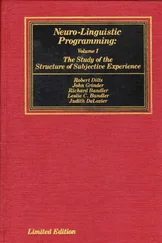Lynn: I don't know.
I don't care if you understand what I said. Just tell me what words I used.
Lynn: I don't know; I don't remember. It's erased.
Did you all notice that when I asked her that question requesting auditory information, I waved my arm directing her gaze up and to her left. She followed, so she was looking in a direction that allowed her to access visual information, but not auditory. That's another way to get dissociation. So it's no surprise that she reported being amnesic for what I said.
Do you remember what I said this time? (He waves his arm down and to her left.)
Lynn: You said I was amnesic, since you directed me to access visual
information and not auditory.
Right. She can recover what I said when I direct her to the appropriate channel. If I want amnesia, I direct her into an inappropriate channel. Since I asked her to recall what I said, it's appropriate to direct her to look down and to her left, if I want her to be able to recall it. If I want her to be able to recall the movements of my arms, I would direct her gaze up and to her left. So if I deliberately direct her into a channel other than the one where the information is stored, she will be amnesic.
Amnesia is traditionally thought of as one of the most difficult deep trance phenomena to get. If you understand accessing cues and states of consciousness in the way that we have been describing them here, all you have to do is misdirect a person and you get amnesia.
Man: What about getting the amnesia to last later on?
It doesn't matter later. A good time to go for amnesia is right after you've made some change or given some instruction. If a person doesn't consciously remember, it can be easier for the new behavior to emerge without conscious interference. If he remembers later on, that's OK.
Sometimes I verbally suggest a dissociation between the person's conscious and unconscious processes in order to get amnesia. For example, I might say: "And as you sit there … I'm going to speak to you … and the more you listen to me … the less you will understand with your conscious mind … the more you will understand with your unconscious mind … because it's your ears that I am speaking to."
What could it mean to tell someone you aren't speaking to him, but to his ears? The result is generally dissociation. Another variation is to say "I'm not speaking to you now; I'm talking to him."
Earlier I offered you another way to suggest amnesia verbally. Before you bring someone out of a trance, you can give him instructions like "And your unconscious mind can sort through everything that has occurred here so that it can let you know only those portions of what has occurred that it believes would be useful for you to know … because it can be so delightful to find yourself using new choices . . , and you don't know where they came from." Or "And you can remember to forget to remember any material best left at the unconscious level."
Recovering Personal History
Organizations known roughly as uthe law," and also organizations that exist to protect people from too much justice, frequently hire experts in hypnosis to aid them in recovering information about past events. One of the things that people do exquisitely in altered states is relive experiences. In fact, most of the psychotherapies that have people relive past experiences use hypnotic technology to get them to do so. Some psychotherapists use these hypnotic techniques much more effectively than many professional hypnotists.
The easiest way to get someone to relive an experience is to do the same thing you did when you practiced the induction method of accessing a previous trance. All you do is begin with the first thing that you know led up to the event, have the person recall that in detail, and then proceeded from there. If you do this, the person will have the same responses he had the first time.
Once I worked with a businessman who told me that he went into a meditative state when he got on airplanes. He said 'The way I experience it, one moment we're taking off and the next thing I know, the plane is landing." I was curious about what happened, so I had him reaccess that experience. First I had him walk up the ramp onto the airplane, sit down and put on his seat belt, and then have the usual conversation with the stewardess about his coat and whether he wanted a drink. Then as the plane was taking off, I had him listen to the captain announcing how high they would be flying. As soon as I went through all that, his head dropped forward, and he ceased to respond to me. 1 hen he started snoring. He didn't go into a meditative state on airplanes; he went to sleep. Each time 1 led him through the same progression, he fell asleep, and I had to shout "Hey, you! Wake up!" Later on I discovered that if I just made the sound "Urp Urp" and jiggled his chair a little bit, he'd arouse and ask "Are we there yet?" If you want to know what happened in the past, you'll find out if you have the person relive the experience fully enough.
A man who is fairly skilled at using these techniques came up to me in a workshop and told me about two young female clients of his. They had been abducted and raped when they were out somewhere together. One of them remembered the event vividly, and had given the police all the necessary information. The other one had complete amnesia for the event and didn't quite believe the story that the first one had told. The one who remembered the rape vividly was a psychological mess as a result of it, while the other one had no response to it. She was fine.
In a situation like this, you need to consider carefully whether there is any point to her knowing what happened. If there isn't, recovering the memory may only give her pain.
This well–intentioned therapist was working diligently to get the woman who didn't remember anything to remember the event in detail, so that she could feel all of the pain. He decided that she had repressed all that unpleasantness, and he was right! However, repressing unpleasantness is an excellent choice in some situations. He placed a value judgement upon "truth" and assumed that since it was repressed, it would come out and be harmful to her later on, so she might as well have the pain now and get it over with.
If you use hypnosis to lead people into awareness of unpleasant experiences, I think you should first make a choice about whether that is worthwhile. Many of us were taught that reliving unpleasant experiences makes them less harmful, and that absolutely, categorically, is not so. If there is one thing that academic psychology has learned, it's that that assumption is false. Academic psychology has learned that if a certain set of experiences teaches you to have a generalization, going through the same experiences again will only reinforce whatever you learned from them. If what you learned from an event causes you limitations, reliving that event over and over again in the same way will only reinforce your generalization and the limitations that result from that generalization.
Therapists like Virginia Satir and Milton Erickson all have people go back and relive events, but they have people do it differently than the event occurred the first time. Satir describes this as "going back and seeing with new eyes," whatever that means. Erickson had people go back into the past, and then he changed things totally. He reorganized history so that it had no alternative but to be different.
Once Milton did a fascinating thing with somebody. A client came in who had made a mistake as a very young child; he had committed a crime. Something about the course of events convinced him that from that point on he would engage in criminal activities. He became convinced that he would always make the same mistake, and so he did.
Читать дальше











